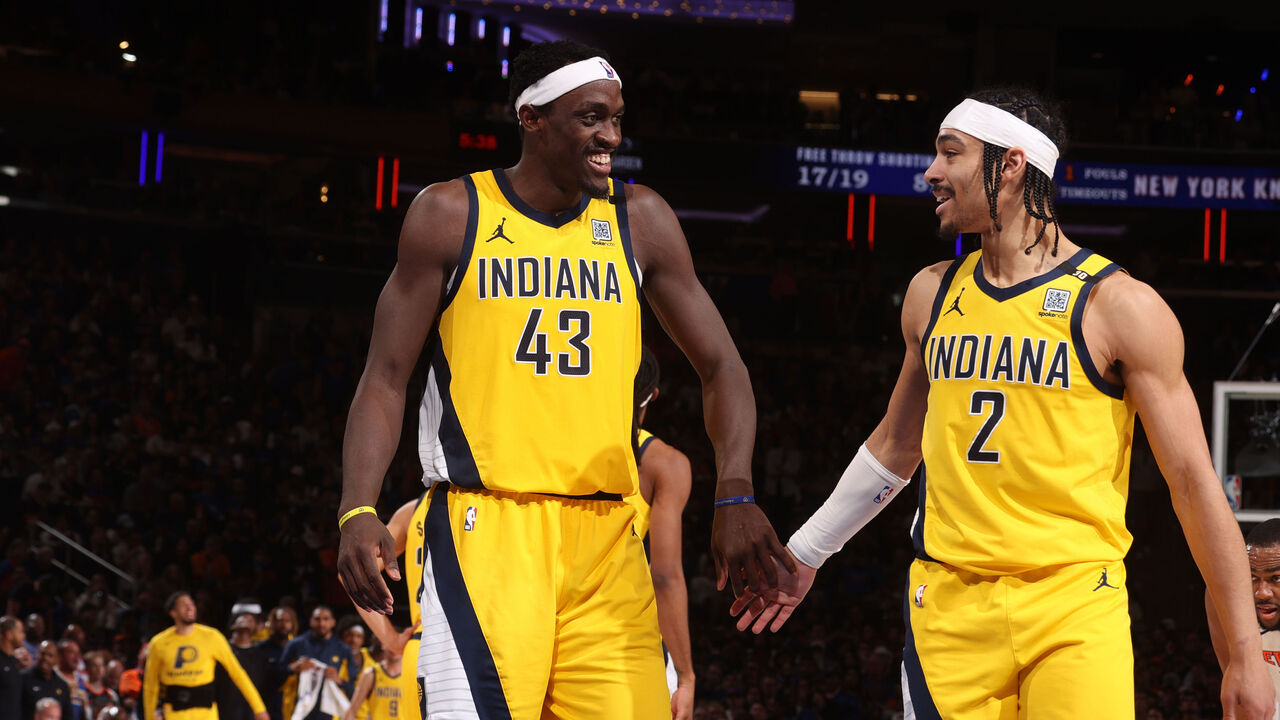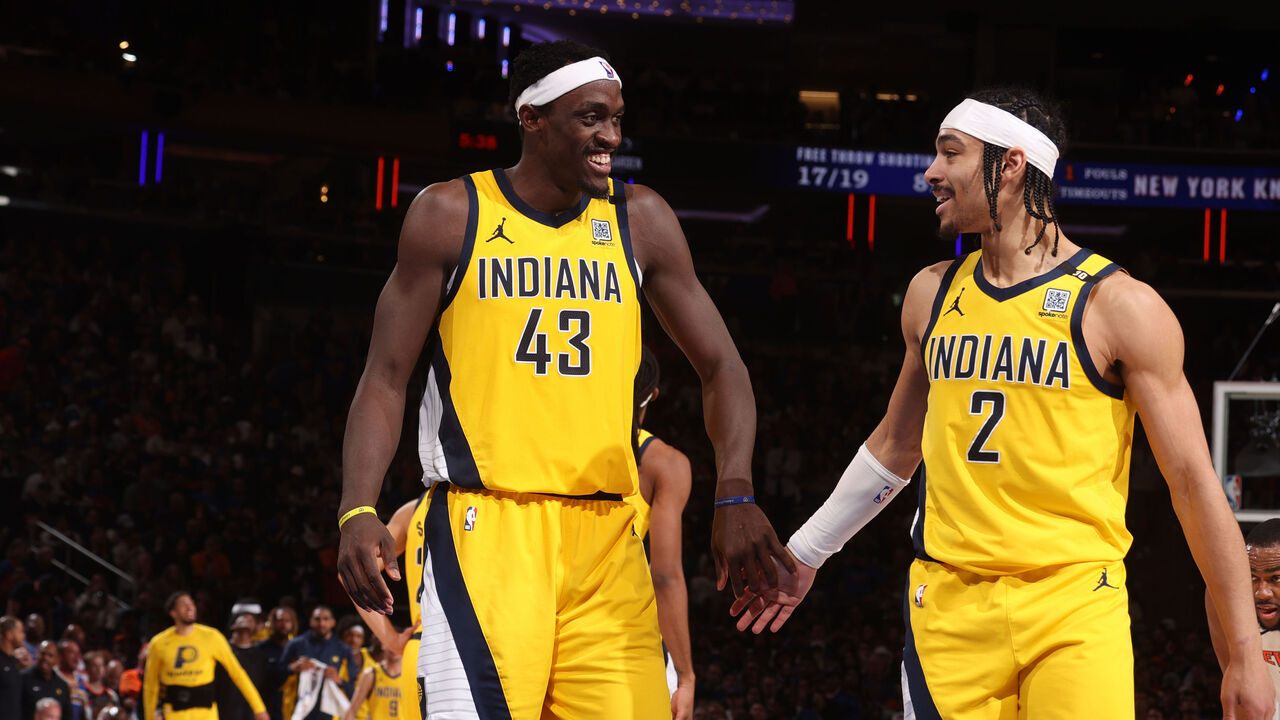Can the Pacers build on their breakthrough?
Every so often, a middle-of-the-road playoff team will, through a combination of matchup fortune and timely performance, unexpectedly punch through to the conference finals. Most of the time, that team is dispatched by a true contender and left to ponder its next steps after being reminded of the sizable gap it still needs to close.
That’s where the Indiana Pacers find themselves after capping a fun and frenetic 47-win season with a thoroughly strange playoff run, in which they overcame wounded versions of the Bucks and Knicks before playing arguably their best basketball in a competitive sweep at the hands of the 64-win Celtics. They led in the final minute of three of those games, despite missing Tyrese Haliburton for the last two.
People will invoke the 2021 Hawks as a comparison, which feels apt mainly because of the similarly gifted point guards at the heart of each team, and the similar challenges that come with trying to build a competent defense around them. The 2019 Blazers had a lot more experience and prior success when they broke through, but they’re an even closer sibling in terms of how the conference finals played out for them. That team – also built around an offensively brilliant, defensively flawed point guard – also earned a moral victory in getting swept by a juggernaut. (The Blazers held second-half leads of 15, 13, and 17 in Games 2, 3, and 4 of that series, only to succumb in all three to the dynastic Warriors.)
Those teams also beat healthier, more impressive competition en route to the final four than the Pacers did, and in spite of that, neither team was able to replicate its breakthrough success in the ensuing years. Neither’s won a playoff series since.
Every team is its own unique organism, so those two don’t necessarily read as cautionary tales for Indiana, which has more 25-and-under talent than either squad did at the time. (Haliburton, Andrew Nembhard, Aaron Nesmith, Bennedict Mathurin, Ben Sheppard, and Jarace Walker is a nice young core. Myles Turner’s still here and still only 28.) But as the Pacers’ front office charts a path forward this summer, it’s worth keeping in mind that these runs turn out to be blips as often as they prove to be springboards to future glory.
There are two main risks associated with buying too heavily into an unexpectedly successful season: doing too much (i.e. hitting the accelerator and making pricy win-now moves before the team is ready), or doing too little (assuming things will continue to progress on an upward trajectory rather than taking steps to address clear weaknesses). And the line separating those two extremes can be paper thin.
Part of what makes the Pacers different is that they already made their big win-now move when they swung for Pascal Siakam at this year’s trade deadline. The 30-year-old two-time All-NBAer isn’t on the exact same timeline as the rest of the core, but he was a near-perfect on-court fit, and the trade didn’t cost Indiana much in terms of assets (Bruce Brown, two late first-round picks in this year’s maligned draft, and another 2026 first-rounder that’s also expected to fall in the late teens or 20s). That deal will continue to look like a steal for the Pacers even after they lavish Siakam with a lucrative new contract this offseason.
Siakam and Haliburton didn’t get to showcase the full extent of their capabilities as a tandem this season because Haliburton strained his hamstring before the trade and never came close to recapturing his pre-injury form after returning. They’ll be a more dangerous duo after Haliburton gets healthy and they spend an offseason workshopping their two-man game.
Siakam still got to demonstrate exactly why the Pacers saw fit to acquire him. He gave them the mismatch-hunting, post-up, and mid-range scoring dimension that all teams need against playoff defenses and that Indiana wouldn’t have got from anyone else. They wouldn’t have beat the Knicks or possibly even the Giannis-less Bucks without him. And though he couldn’t help them close out a single win over Boston, the fact he gave buckets to every All-Defensive-caliber stopper the Celtics threw at him (to the tune of 23-8-5 on 58% true shooting) felt very encouraging.
As did the fact Nembhard, the second-year guard already having a breakout postseason, proved plenty capable of taking the reins of Indiana’s offense after Haliburton went down. Nembhard put up 56 points on 22-of-39 shooting with 19 assists to just five turnovers across Games 3 and 4. He did that while primarily being guarded by Jrue Holiday and Derrick White and while frequently guarding the likes of Jayson Tatum and Jaylen Brown at the other end. Even though he got his cookies stolen by Holiday to seal a heartbreaking Game 3 loss, it was the kind of showcase that teases star potential.
The 24-year-old finished the playoffs with averages of 15 points and 5.5 assists on 65% true shooting, which included him shooting 74% at the rim and 66% on long mid-rangers. His arrhythmic, stop-and-start driving game, and the mid-range and floater-range touch that goes with it, has some shades of his compatriot in Oklahoma City. (This is a stylistic comparison, not a qualitative one; let’s not get too crazy.)

We know the Pacers can score with anyone. Haliburton’s one of the best offensive orchestrators in the game, able to conduct a lethal transition attack while applying the same quick-hitting ethos to the half court. The combination of his shooting, passing vision, and – when he’s physically right – driving ability allows him to bend defenses and then break them. Throw in a star playmaking forward and a bourgeoning secondary ball-handler who can take the pressure off him, along with a stretch center in Turner whose scoring package gets a bit more well-rounded every year, and this offense that ranked second during the regular season and first in the playoffs should continue to reside in the NBA’s upper echelon.
But there are obviously major holes to patch at the other end, where the Pacers ranked 24th in defensive efficiency during the regular season and 13th out of 16 in the playoffs. They also ranked 26th in defensive rebound rate and 14th in the playoffs. A look at their starting lineup suggests they shouldn’t be that bad, with four average to above-average defenders in Nembhard, Nesmith, Siakam, and Turner surrounding Haliburton. But Haliburton may be the type of liability who needs to be insulated by elite team defenders, and with Turner backsliding significantly in that regard and Siakam a long way from his defensive peak, Indiana doesn’t have that.
Perhaps internal improvement can provide an answer, with promising hybrid forward Jarace Walker waiting in the wings. Maybe Isaiah Jackson’s flashes are ready to coalesce into a consistent bright spot. Maybe Nesmith can take another step forward or Turner can rediscover his all-world rim-protection. It’s worth pointing out that the Pacers tweaked their scheme late in the season to layer in more help, and after allowing a 37.6% opponent rim frequency (highest in the league) during the regular season, that number dipped to 30.9% (seventh lowest) in the playoffs.
The bottom line is they still need more point-of-attack resistance, more secondary rim-protection, more rebounding grit, more size on the wing, and probably a better answer at backup center. That seems like a lot to address but those are all interconnected deficiencies that could theoretically be improved with a couple of savvy additions. Although Siakam’s cap hold leaves Indiana without much cap space, these wouldn’t have to be blockbuster moves. Heck, look at what Derrick Jones Jr. has done for the Mavericks on a minimum deal.
It won’t be easy finding guys who can meaningfully improve the Pacers’ defense without taking too much away from their offense, but there are options, especially because Haliburton is the type of playmaker who can optimize specialists and mask offensive liabilities. The Pacers could have access to the full mid-level exception, which they can use to splurge on one guy or spread around to a few helpful contributors. Think Naji Marshall, Nic Batum, or maybe even Jones himself. Do the Pacers believe in Isaac Okoro’s offensive development? Can I interest them in a lightly used Precious Achiuwa?
Obi Toppin made a strong case this season to be retained, and Indiana even got away with playing him at center some in the postseason, but he’s one of the worst rebounding and rim-protecting bigs in the league. Jalen Smith had a terrific offensive season but very quickly proved to be unplayable in the playoffs, and the Pacers should let him walk if he declines his player option.
They can explore the trade market armed with the type of young pieces who can get them in the mix for an elite defensive role player like Alex Caruso, Deni Avdija, or Jonathan Isaac. They don’t need to rush things, but they can’t afford to be complacent, either. Acquiring Siakam accelerated their timeline, because the co-star who’ll soon be taking up about 30% of their cap is at the back end of his prime. None of Mathurin, Sheppard, or Jackson should be off-limits if the right deal presents itself.
Building on a breakthrough like this, when expectations suddenly ramp up and the rest of the league catches onto what you’re doing, is one of the biggest team-building challenges in the sport. The Pacers can’t just run this back and expect the same result; they could improve a great deal and still not make it back to the East finals because their bracket is unlikely to be as forgiving as it was this year. But they’re a good team with room to grow, and the right moves on the margins could make this season look more like the start of something significant than a flash in the pan.


